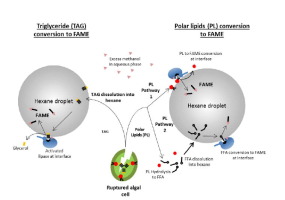Bioresource Technology ( IF 11.4 ) Pub Date : 2018-04-01 , DOI: 10.1016/j.biortech.2018.03.129 Sam Q.K. Law , Ronald Halim , Peter J. Scales , Gregory J.O. Martin

|
A single-step method for transesterifying and recovering lipids in concentrated slurries (ca 20% w/w solids) of ruptured microalgae is presented. A soluble Rhizomucor miehei lipase (RML) was used to directly transesterify the lipids in the marine microalgae Nannochloropsis salina. This allowed both triglycerides (TAG) and polar saponifiable lipids to be recovered as fatty acid methyl esters (FAME) using a nonpolar solvent (hexane). Up to 90 wt% of the total saponifiable lipids (SL) were converted to FAME within 24 h, approximately 75% of which was recovered in the hexane by centrifugation. Two pathways for the conversion and recovery of polar lipids were identified. The water in the slurry buffered against potential lipase inhibition by methanol, but necessitated a high methanol dose for maximal FAME conversion. Nonetheless the method enables the recovery of polar lipids as FAME while avoiding the need for both drying of the biomass and a downstream transesterification step.
中文翻译:

使用非极性溶剂通过脂肪酶辅助提取从微藻中转化和回收皂化脂质
提出了一种用于酯化和回收破裂微藻类浓缩浆液(固体含量约20%w / w)中脂质的单步方法。可溶性根瘤菌miehei脂肪酶(RML)用于直接酯交换海洋微藻Nannochloropsis salina中的脂质。这允许使用非极性溶剂(己烷)将甘油三酸酯(TAG)和可皂化的极性极性脂回收为脂肪酸甲酯(FAME)。在24小时内,高达90 wt%的总可皂化脂质(SL)被转化为FAME,其中约75%的脂质通过离心回收在己烷中。确定了极性脂质转化和回收的两种途径。浆液中的水可缓冲甲醇对脂肪酶的潜在抑制作用,但是必须使用高剂量的甲醇才能实现最大的FAME转化率。尽管如此,该方法能够将极性脂质作为FAME回收,同时避免了干燥生物质和下游酯交换步骤的需要。



























 京公网安备 11010802027423号
京公网安备 11010802027423号